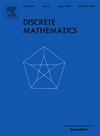Fractional colorings of partial t-trees with no large clique
IF 0.7
3区 数学
Q2 MATHEMATICS
引用次数: 0
Abstract
Dvořák and Kawarabayashi [2] asked, what is the largest chromatic number attainable by a graph of treewidth t with no subgraph? In this paper, we consider the fractional version of this question. We prove that if G has treewidth t and clique number , then , and we show that this bound is tight for . We also show that for each value , there exists a graph G of a large treewidth t and clique number satisfying , which is approximately equal to the upper bound for small values c.
无大团的部分t树的分式着色
Dvořák和Kawarabayashi[2]问,没有Kr子图的树宽为t的图所能达到的最大色数是多少?在本文中,我们考虑这个问题的分数形式。证明了如果G具有树宽t且团数2≤ω≤t,则χf(G)≤t+ω - 1t,并证明了该界在ω=t时是紧的。我们还证明了对于每一个值0<;c<12,存在一个大树宽t且团数ω=⌊(1−c)t⌋的图G,满足χf(G)≥t+1+12log(1−2c)+o(1),它近似等于小值c的上界。
本文章由计算机程序翻译,如有差异,请以英文原文为准。
求助全文
约1分钟内获得全文
求助全文
来源期刊

Discrete Mathematics
数学-数学
CiteScore
1.50
自引率
12.50%
发文量
424
审稿时长
6 months
期刊介绍:
Discrete Mathematics provides a common forum for significant research in many areas of discrete mathematics and combinatorics. Among the fields covered by Discrete Mathematics are graph and hypergraph theory, enumeration, coding theory, block designs, the combinatorics of partially ordered sets, extremal set theory, matroid theory, algebraic combinatorics, discrete geometry, matrices, and discrete probability theory.
Items in the journal include research articles (Contributions or Notes, depending on length) and survey/expository articles (Perspectives). Efforts are made to process the submission of Notes (short articles) quickly. The Perspectives section features expository articles accessible to a broad audience that cast new light or present unifying points of view on well-known or insufficiently-known topics.
 求助内容:
求助内容: 应助结果提醒方式:
应助结果提醒方式:


